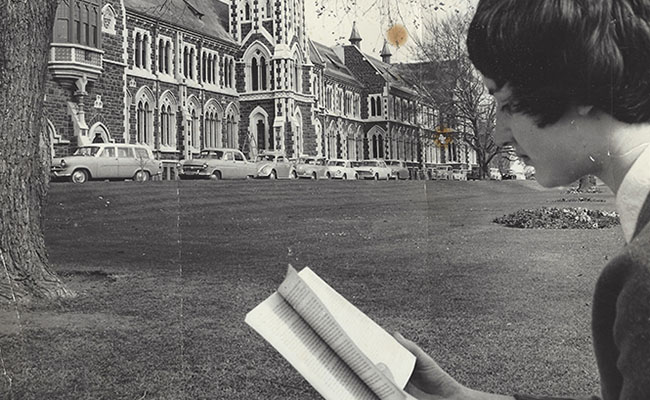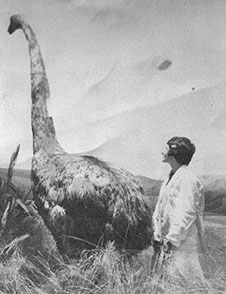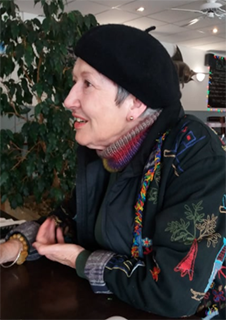
Otago alumna Kay Flavell sitting by the Leith, c1962, when snapped by an Evening Star photographer in search of a 'typical student photo'.
At the alumni event in San Francisco last year, we caught up with inspiring alumna Dr Kay Flavell. It was no surprise to hear that since we featured her in Otago Magazine in 2010, she's packed the intervening years with a whirlwind of community projects, writing and academic pursuits.
Kay studied languages at Otago and went on to teach at the University of Canterbury and then University College London. In 1983 she took up a professorship in German literature at the University of California (Davis), she gained a master's degree in museum studies from Monash University in Melbourne and began to branch into projects with schools, libraries and community groups.
This led to her creating the New Pacific Studio – an international charitable organisation fostering collaboration among creative communities around the north and south Pacific. To support this goal, Kay established artists' retreats in Vallejo, Northern California, and Mount Bruce in the Wairarapa.
In her own words, Kay tells us what she's been up to lately:
 Do you still divide your time between Aotearoa New Zealand and California, are both home to you?
Do you still divide your time between Aotearoa New Zealand and California, are both home to you?
No, family obligations intervened. As my two California-born grandchildren (now 18 and 15) were growing up, my daughter wanted me to be around more, so 10 years ago in 2013 I handed over the directing of the New Pacific Studio in New Zealand (now New Zealand Pacific Studio) to the very capable Jodie Dalgleish, co-owners Ian and Lynette Dewes, and a wonderful board.
The New Zealand Pacific Studio continues to thrive. The original base at Normandell in Mount Bruce was sold some years ago and the programme now operates out of various spaces around the Wairarapa. Madeleine Slavick is the present chair, and artist residencies have resumed after a three-year gap because of COVID. My current role is as an honorary life member and sponsor of a poetry fellowship.

Kay inside a display case with a moa at the Otago Museum, c1960.
I will always feel at home in New Zealand, and glad that I was able to come back, reconnect and contribute after being away for 37 years. I feel the land and people are inside me now, forever.
I continue to direct New Pacific Studio in Vallejo.
 Where else have the past 13 years taken you?
Where else have the past 13 years taken you?
From 2014 to 2019 I got caught up in an environmental battle here in Vallejo. An Irish multinational cement company proposed setting up a huge cement plant on our Napa River waterfront, on the site of a historic flour mill, very close to a school and houses. Our community fought back, setting up a Fresh Air Vallejo project, and I used the traditional tools of story-collecting and historic preservation to grow community support.
My years in New Zealand helping to set up Friends of Anzac Bridge between 2002 and 2010 had given me very useful activist experience! And we won. The cement company gave up and left town.
 Tell us about some of your recent publications?
Tell us about some of your recent publications?
Rainbows Over Mauriceville (2014) collects the stories and photos of the Scandinavian migration and settlement of the Mauriceville district that lay beside our residency in Kaiparoro, Mount Bruce.
In my 2008 book Living in Kaiparoro I had included an invoice from October 1892 from Norwegian immigrant farmer Ole Isakson, living in Mauriceville North, for clearing 63 acres of native forest on behalf of the Yorkshire immigrant clockmaker and farmer Christopher Burton, who purchased 750 acres.
That document had been preserved by Ron Burton, Christopher Burton's grandson. I was able to share it with Ole's grandson, Ken Isakson, who was living in Masterton. Many other neighbours, including Bridget Percy also had Scandinavian connections.
Because of my interest in cultural heritage, I put together first a small brochure Footsteps through the Forty Mile Bush, and then a longer booklet, Whispering Roads, Wellington to Napier - A Scandinavian Trail. That was published on behalf of Friends of Mauriceville in 2011. It is available online at www.scandinaviantrail.org.nz.
 And your latest book, People of the Lane, how did that come about?
And your latest book, People of the Lane, how did that come about?
People of the Lane (2021) had a 40-year birth! It is an oral history of the shopkeepers and residents of a beautiful area in Liverpool called Lark Lane and Sefton Park. It's just three miles from the city centre, with a huge park on one side and the River Mersey on the other. Lark Lane is the connector.
I found myself living there in 1980 and was so fascinated by its mixture of social classes and its signs of decline and regeneration, plus the talk going on everywhere, that I decided I wanted to record the present moment on my tape recorder. (I was on unpaid leave from University College London that year). I gave a hundred pounds to a young Irish photographer called Tom Wood to work independently on the project.

Kay talking with author Philip Marshall in Paekākāriki, c2018.
I transcribed the tapes onto my old Olympia typewriter, and then in 1983 I moved with my family to California. Back then, in the era before email and the Internet, there was no way for me to turn the stories into a book. So they were put aside.
Fast forward to 2019. That summer, after the end of our Vallejo battle, I decided to visit some other old industrial river cities to see how they had revitalized their waterfronts. I thought of Liverpool, and then remembered my work of long ago. Could I even find it? I did, I had it digitized, and took it with me.
Archivists in Liverpool were encouraging, and a friend told me of a special Facebook page called People from around Lark Lane. At once I knew that with the help of members of that website it would be possible to complete the book, bring it up to date and get the stories of local people back into their own hands at last. A two-year project followed, coinciding with the COVID epidemic, so that forms part of the story.
 How did Heathrow and Paris Tales emerge from COVID?
How did Heathrow and Paris Tales emerge from COVID?
As a wandering scribe, I collect stories wherever I wander. Including long delays at airports, and when dining alone in restaurants.
 You are currently writing your memoir, Escape from Signal Hill, what is it like to revisit the different periods of your life?
You are currently writing your memoir, Escape from Signal Hill, what is it like to revisit the different periods of your life?
Vivid, intense, painful, joyful, grateful for so many opportunities for travel and adventure. Especially grateful for the last two decades post-university, and the amazing friends and helpers met along the way. Thanks for the initial springboard, University of Otago!
 You are also working on a study of an 18th-century Liverpool heiress, Hannah Lightbody?
You are also working on a study of an 18th-century Liverpool heiress, Hannah Lightbody?
I've just come back from five weeks in Liverpool, promoting People of the Lane, and leading guided tours From the Park to the River. I'm interested in the diary kept from 1786-90 by young Hannah Lightbody, before her marriage to industrialist Samuel Greg, founder of Quarry Bank Mill near Manchester. In Liverpool in these years the opposition to the African Slave Trade is growing, led by Hannah's older friends and mentors. But her family networks are closely implicated in the trade. What role can she play? What is the power of a woman's voice? Role of silence?
